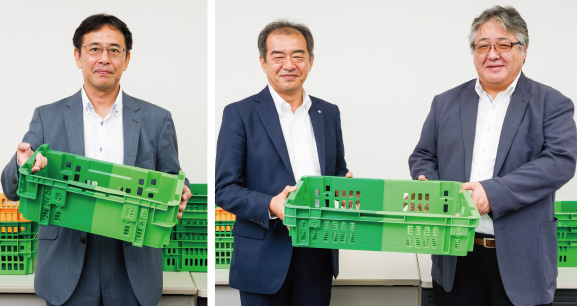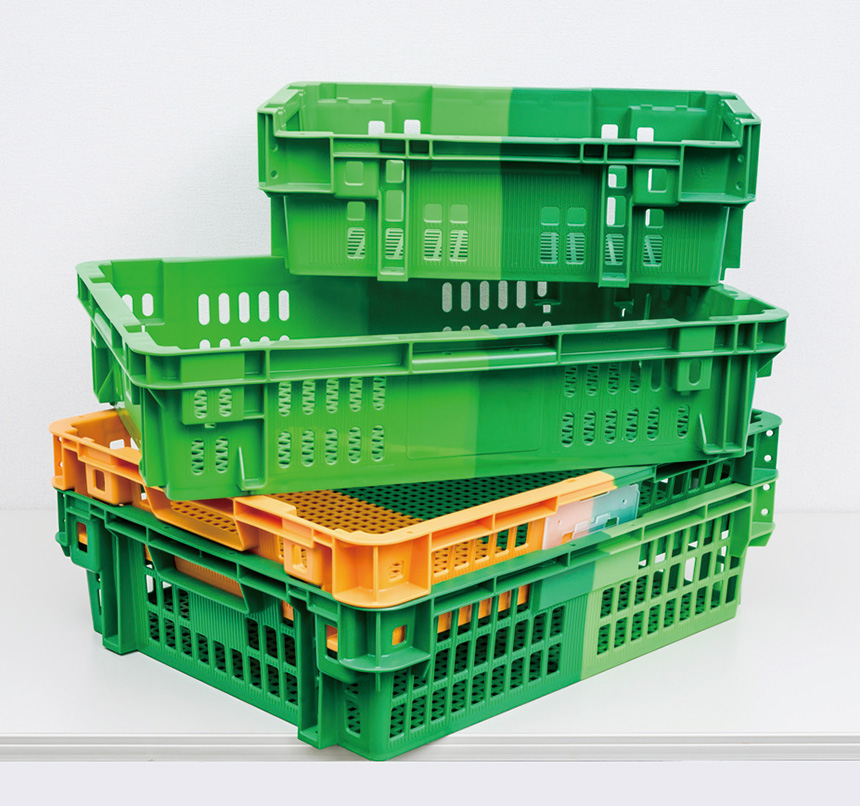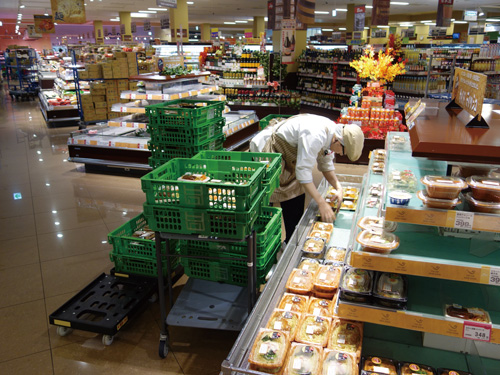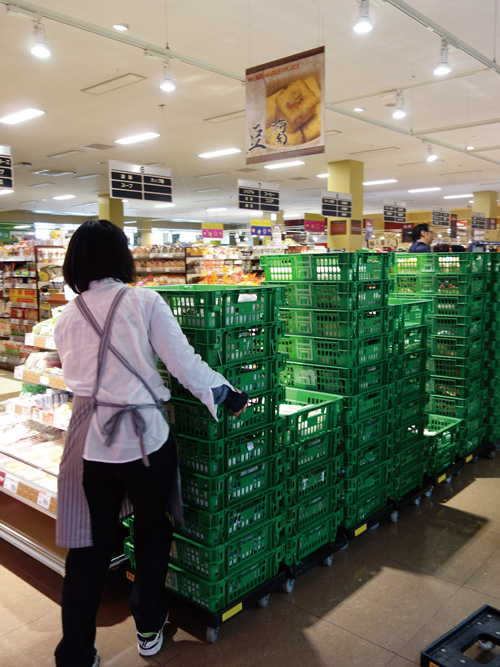Logistics crate standardization Council
Promoting the sharing of standard crates by utilizing "epal", a web-based logistics equipment management system
*The information at the time of publication in November 2016 posted as it is.
*The company names and product names mentioned are registered trademarks or trademarks of their respective companies.
The Logistics crate standardization Council standardized the specifications of plastic logistics containers and crates used for delivery to supermarkets, mainly products called Japanese-delivery (tofu, raw noodles, paste, pickles, etc.). They aim to realize a recycling-oriented society and improve logistics efficiency by promoting shared use of standard crates, which are returnable containers. We interviewed Mr. Norio Eguchi, an auditor of the council, who is promoting the standardization of crates, and is trying to expand their use, along with Mr. Hideki Murai and Mr. Shigeki Asai of UNY Co., Ltd.

From left: Mr. Norio Eguchi, Executive Director, General Incorporated Association Japan Supermarket Association
Mr. Shigeki Asai General Manager and Mr. Hideki Murai, Chief Manager, Logistics Department, Logistics Div., UNY Co., Ltd.
Deciding the standard of the standard crate and launching in 2009
The Logistics crate standardization Council (The council) is a council consisting of three distribution groups: Japan Supermarket Association, Japan Chain Stores Association, and New Japan Supermarket Association. Established in October 2005, they have been working on the standardization of so-called crates, which are plastic containers used as returnable boxes in the food distribution industry.
In April 2007, a total of four standard crate standards were determined: the food crate standard type I and the food crate type II (shallow/deep/half). In April 2009, four companies in the Kansai area started sharing standard crates, and in the same year, two companies in the Kanto area and UNY Co., Ltd. (Chukyo Area) were newly introduced in the Chubu area. In March of the following year, 10 major supermarkets in Yamanashi Prefecture introduced standard crates, of which UNY Co., Ltd. introduced them in Shizuoka Prefecture in addition to Yamanashi Prefecture. Since then, standard crates have been introduced in the Tokyo metropolitan area, Hokuriku district, Chugoku/Shikoku district, and Kyushu district, and as of August 2016, approximately 180,000 crates circulate per day at 29 chains and 56 distribution centers. The number of companies in each association is still small based on the number of members of each association, but the standard crate’s use has been gradually expanding over the past seven years.
There were various problems with crates in different sizes
In general, large manufacturers often build a production line that automatically packs products into corrugated board in order to improve the efficiency in factories. Vendors (manufacturers and wholesalers) that deliver in crates also prepare their own crates, so naturally the most efficient crates calculated from the size of the product will be selected. However, on the supermarket side, where various products are delivered from many vendors, logistics containers of various sizes such as crates and cardboard are received every day. Diversification in size complicates work in various areas such as transportation, delivery, and management of empty containers. The council was established to eliminate such situations. Mr. Norio Eguchi, who is a director and secretary general of the Japan Supermarket Association, and also an auditor at the Logistics crate standardization council, explains the process.

4 types of crate with unified standards
"At a supermarket distribution center, crates of various shapes received from vendors were piled up in a basket car like a puzzle. Because of the different sizes, there is a risk that the crates will collapse on the truck bed during delivery. The same is true in supermarkets. The crates are piled up both during and after the product is delivered, and since it is in an unstable state, there were accidents where it collapsed onto people and things. In order to solve the problem, we should use crates of the same size throughout the manufacturing, distribution, and sales supply chain, and in 2004, we examined the standardization of crates within our logistics system committee."
About 30 companies participated when the council was established. UNY Co., Ltd. also participated in the council from the beginning. The company operates mainly in the Chukyo area and currently has 11 distribution centers. Mr. Hideki Murai, Chief Manager of the Logistics Department (former General Manager of the Logistics Department) of the Logistics Div. of the company, recalls the time when he participated in the meeting as follows.
"Manufacturers select containers according to the size of their products, so it is natural for the sizes to be different. However, in order to return the crates from the center, it is necessary to sort the empty crates. If there is corrugated cardboard, it must be discarded. This work is quite time-consuming, but at that time it was too common to see the inconvenience as a necessary inconvenience. At the time, I was wondering if there was a way to improve the efficiency of the work, and I saw the light when heard about the standardization efforts of the council. I felt that I should promote the standardization of crates."
The work of sorting the crates takes time because there are many types, and a place to store them until collection is also required. However, the backyard of the store is actually small, and there is no space to store crates for each type. Inevitably, there is no choice but to stack crates of different types in an unstable state. Even if it is successfully collected from the store to the distribution center, since the crates of each company are mixed, sorting work will occur again. Each of these detailed tasks burdens stores, distribution centers, and even drivers.
Public call for inventory management system JPR’s "epal" selected
The council sought sharing alongside standardization of crates. Even if the size of the crate is standardized, if the manufacturer's name etc. is included in the standard crate used by each company, it will still be necessary to sort crates at the store or distribution center, and the standardization will lose meaning.
The council came to the conclusion that in order to share the standard crate without any names, it was necessary to manage the inventory of the crate itself, and adopted the JPR's web logistics equipment inventory management system "epal."
"Once we decided on the standard for the standard crate, we publicly called for an inventory management system. After repeatedly listening to the applicants at the council, we finally decided to introduce JPR's "epal". We came to the decision for its great track record of using the system as an inventory management system for rental pallets, along with functions and costs of the system," says Mr. Eguchi. Mr. Murai continued, "I had a concrete image that the crate could be standardized and shared by the same mechanism as the rental pallet, so we asked JPR as a council."
By actually introducing the inventory management system, it is possible to understand who is using the standard crate without the name label, and to share this information. In addition, management awareness of the crate has been improved, leading to a reduction in the loss rate.
Reduction in carbon footprint, improvement of truck loading efficiency, and reduction of the burden of display work at stores
The usage of standard crate at UNY Co., Ltd. is as follows.
The company rents 23,000 standard type II crates from a rental company and rents them to each vendor in the Chubu area and Yamanashi prefecture. Products are loaded onto the standard crates and delivered to the company's distribution center, and products are transported from the center to each store using standard crates. The products that use the standard crate are mostly Japanese foods, some Western foods, seafood, and processed foods.
Mr. Shigeki Asai, General Manager of Logistics Department, Logistics Div., UNY Co., Ltd., explains the advantages of standard crates:
"Vendors don't have to buy cardboard or their own crates, and if other supermarkets also use standard crates, their operations will be even more efficient. Also at our company, as the recipient, at the base and at the store, it will be easier to perform various tasks. Also, since the size is the same, there is less concern about it breaking during transportation, and it will also help the driver's safety and security. The spread of standard crates will make things more convenient for everyone."

Since the size of the crate is uniform, it is possible to take out goods quickly
Retailers have confirmed various positive effects since the introduction of standard crates: the effect of the reduction of transportation of basket cars at stores, reduction of the burden of store display work and tidying up, environmental effects such as carbon footprint reduction by reducing corrugated cardboard, and loading of trucks being more efficient.
Future issues are the unification of ownership, expansion of users and product categories
The standard crate mechanism itself is running well. Mr. Eguchi considers future developments as follows.
"The next thing we have to do is to unify how we own the crates. Currently, some companies have rented standard crates, while others have their own. There are issues of processing when the inventory balance of each owner is different, so I think it will be more convenient to unify it by renting."
Improving management accuracy is essential for expansion. Currently, standard crates are inventoried twice a year, and the most recent deviation is about 3%.
"We need to make sure that even the council works to improve management accuracy. I still feel that individual management is necessary, but there are many challenges," says Mr. Eguchi.
The introduction of an individual management system is not technically difficult. However, adding tags and barcodes that can withstand washing and be used many times (carrying more than 2 million pieces each) requires a certain amount of cost, labor and time.

Can be carried stably even if crate is piled up
"A change in management system requires an initial investment, and it will change operation to some extent. First of all, I would like to discuss what kind of management is good at the council. I think that unifying the methods and expanding the product categories with companies that use standard crates are priorities."
Currently, the standard crate has not been introduced to retailers in the Tohoku region and Hokkaido. How should they increase the number of companies using standard crates nationwide? In addition, they are looking for ways to expand their use in categories other than Japanese foods, such as milk, bread, vegetables, and fruits.
Mr. Murai talks about his enthusiasm for the future. "If standard crates spread all over the country, the cost of standard crate rental and management can be further reduced. There is no choice but to do it as a whole. We will continue to work on it."
Currently, JPR provides the web logistics equipment inventory management system "epal" and is also in charge of the secretariat of the council. We are working with the council to solve problems. JPR will continue to cooperate with the council to support the promotion of standard crates.

